Vanderbilt Sees Downstream Benefits From Integrating Genomic Results Into EHR
This week the National Human Genome Research Institute is holding a meeting to discuss progress and identify solutions to genomic medicine implementation challenges. Participants from academic medical centers are presenting examples of how “genomic learning healthcare systems” apply cycles of genomic medicine implementation, evaluation, adjustment, and updated implementation practices across their delivery systems.
One of the speakers was Travis Osterman, D.O., M.S., a medical oncologist, informatician, clinical director in the Office of the Chief Health Information Officer at Vanderbilt University Medical Center (VUMC), and director of Cancer Clinical Informatics in the Vanderbilt-Ingram Cancer Center. His talk focused on progress made integrating clinical genomic results into the electronic health record and some of the downstream benefits Vanderbilt is seeing from that.
Osterman gave the audience an update on some recommendations in a 2015 National Academy of Medicine report on this topic. The first was establishing data standards and common ways of representing outcomes that would facilitate the scalability and translation of genomic information into clinical care. The second was integrating genomic data into the clinic through clinical decision support, so the guidance is scalable and interoperable.
He praised the HL7 clinical genomics working group for its work on an evolving data standard for transmitting clinical genomics information that includes pharmacogenomics, somatic and germline information. The standard for trial use was initially published in November of 2018. Today Vanderbilt is one of 29 healthcare systems that are utilizing this data transmission standard to connect to reference laboratories and receive structured information, Osterman said.
“Our tagline at Vanderbilt is ‘making healthcare personal’ and re-examining our efforts in precision medicine led to a clinical genomics workstream, which I help to lead,” Osterman said. “Many of these efforts were already ongoing, and it was bringing them together so we could leverage scale, understand what each of what we jokingly call silos of excellence were doing and make that work across our enterprise.”
In terms of clinical decision support, Osterman said, most health systems are either recommending genomic testing or personalizing care for an individual patient. “That is what we did from 2010 through 2020, and we have a robust pharmacogenomics program. We started that program in 2010, and currently have almost 20 drug-gene interactions that we track. We're both recommending that test in our electronic health record, and then able to integrate those results to help make sure that the right patients are getting the right drugs the right time,” he explained. “This is not necessarily a new phenomenon, but we're trying to expand those same principles into other spaces.”
Osterman spoke about working with Kevin Ess, M.D., Ph.D., who is a pediatric neurologist at Vanderbilt. Ess shared that about 40 percent of pediatric seizure disorders are due to genetic factors. The ones that aren't potentially have an anatomic cause and therefore can go to surgery and potentially have a really good outcome.
Informaticists worked with Ess to identify which specific patients may actually need testing to identify a genetic cause of their seizure disorder, and they developed a clinical work flow to make it happen.
“This is live in our system, and is one of the ways that we're trying to push forward into spaces that are outside of pharmacogenomics,” Osterman said. “We've had several other examples. Routinely, for the last many years, we've been doing both recommended genomic testing and personalized care for individual patients, but I think we need to do more. We need to think not just about individual patients; we need to think about how we do this is for patient populations. We need to think about how we recommend genetic testing or genomic testing to patient populations. Then how do we care for and deliver care to the entire population to personalize their care.”
To do this, Osterman said, we need to get the data out of PDFs. “We want to receive all of those discrete final results, just like any other internal lab that we would order. We want to flow downstream into the electronic health record, and then ultimately both provide patient care and then support our research enterprise,” he added. “We don't want to give up all of those raw unprocessed files, whether that's from our internal genomics lab or whether that's from an external partner. Those are going to go into operational data storage and still may help provide patient care, because we have an internal lab that may leverage those upstream files. Those are going to go into a research repository.”
Vanderbilt went live on Epic's genomics module, which allows health systems to receive those structured results from third-party reference laboratories, in July of 2021. “The real value isn't me receiving those genetic results in my in-basket in our electronic health record,” Osterman said. “The real value is how this benefits all of our downstream processes. The order goes out and the variant data come back into Epic’s database, which is called Chronicles, and it's immediately available to patients. We've talked about putting patients at the center of this. If I have a test that I ordered on one of my patients, that patient can then take that test and show it to another provider, regardless of what electronic health record they're using, because they'll have those data on their phone,” he said.
“We're now able to leverage some of the tools within our electronic health record to do queries that we would otherwise need to do with one of our business intelligence tools. For instance, our electronic health record has the ability to do some kind of rudimentary data visualizations through a tool called Slicer Dicer. And because these are structured data, those work right out of the box, and all of my colleagues can access those data as well,” he said. “Because these are structured data flowing through all of our database systems, they also flow downstream to our research system, called the Research Derivative, which is a copy of our electronic health record use for research. And then that is de-identified in something called the Synthetic Derivative, which then is linked up to our biobank Bioview. By putting these data in structured form, not only are we improving patient care, but these data flow all the way downstream.”
Here is another example of process improvement: “Before we implemented the structured data, when a new first-class drug became approved for cancer treatments, we had data scientists that would query multiple vendor systems; they would take that query, and they would look against our electronic health record system to see which of those patients were still living and who their oncologists were,” Osterman explained. “Then they would give us a report on which patients would potentially benefit from these new treatments after their FDA approval. This process took about one to two weeks, but we thought it was high value, and so we absolutely supported that. I treat primarily lung cancers, and we have 22 approved drugs with targeted variants, and that number continues to grow every year. Now, since we moved to receiving structured data, this process is much, much shorter. When we know that there's a new first-class drug approved, the clinical team can do these queries directly within Epic.”
So how does Osterman think the progress on a genomics learning health system is going overall? “Well, as far as establishing data standards, through the work of HL7, I think we've made tremendous progress,” he said. “And second, integrating clinical decision support, I think we're pushing the envelope. I think there are opportunities to do this even at the population level today.”
What are the next challenges? One is providing a standard way for patients to provide and transfer genetic and genomic information, he said. “I think that's certainly going to be key going forward. I'll take it one step further and say that patients are going to be consenting for large consortium studies and healthcare systems are going to then be asked to share those data with that research consortium, and we need to figure out ways to do that. Finally, I think education is going to be key for both physicians and nurses. This has been a huge effort in our organization.”


